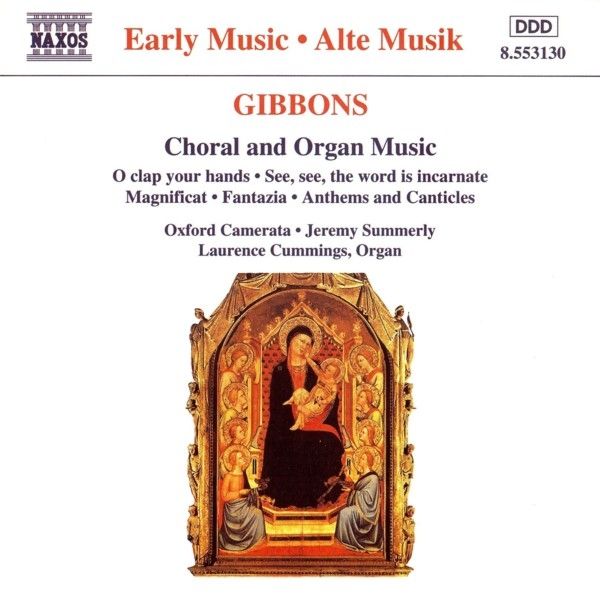
naxos.com
amazon.co.uk
Naxos Early Music · Alte Musik 8.553130
1994

naxos.com
amazon.co.uk
Naxos Early Music · Alte Musik 8.553130
1994
Gibbons' generation was the first to grow up entirely in the new era of
English liturgical music. As such, his music does not show throwbacks
to the older Latin style, but rather rests entirely on clear syllabic
settings. Gibbons' control of harmonic momentum really sets him apart
from his contemporaries. Although this style had a relatively brief
life, Gibbons was undoubtedly its finest exponent.
This is a recording by a fairly small choir, supported by organ. The
selection is representative of Gibbons' sacred output as a whole. The
instrumental support was actually scored by Gibbons in his verse
anthems, although there is a choice available (depending on source)
between using organ or viols.
Along with an assortment of anthems, Gibbons wrote two services for the
Anglican ritual. These are the "Short Service" and the "2nd Service";
the present recording includes the Magnificat/Nunc dimiittis pair from
each of these.
01 - O clap your hands [5:06]
02 - Great Lord of Lords [4:49]
03 - Hosanna to the son of David [2:54]
04 - Prelude in G Major [1:50]
05 - Out of the deep [5:59]
06 - See, see, the word is incarnate [7:40]
07 - Prelude in D minor [1:15]
08 - Lift up your heads [3:12]
09 - Almighty and everlasting God [2:30]
10 - Magnificat (2nd Service) [6:33]
11 - Nunc dimittis (2nd Service) [3:56]
12 - Fantazia of four parts [5:20]
13 - Magnificat (Short Service) [3:20]
14 - Nunc dimittis (Short Service) [2:38]
15 - O God, the king of glory [4:27]
16 - O Lord, in thy wrath [3:50]
Oxford Camerata
Orlando Gibbons
(1583 - 1625) © 1995 Peter James
Jeremy Summerly
Carys-Anne Lane
Rebecca Outram
Lisa Beckley
Deborah Mackay
Robin Blaze
Michael Lees
Andrew Carwood
Steven Harrold
Julian Smallbones
Jonathan Arnold
Robert Evans
Michael McCarthy
Laurence Cummings, organ
Recorded at the Chapel of Hertford College, Oxford, on 29th and 30th
July, 1994.
Continuo organ by Kenneth Tickell & Co. (1990)
Producers: Judy Lieber and Jeremy Summerly
Engineer: John Taylor
Choral and Organ Music
Orlando Gibbons was the most highly-regarded English musician of his
generation. As the Dean of Westminster commented in 1624: "The organ
was touched by the best finger of that age, Mr. Orlando Gibbons".
Gibbons became organist of the Chapel Royal and, later, Westminster
Abbey. His output was not great: church music, a set of madrigals,
keyboard and consort music, and a few other works. The church music
includes thirty-two anthems (including ten verse anthems where sections
for solo voices with independent accompanist alternate with choral
passages) and just two services.
Of the full anthems, O clap your hands - a setting of Psalm 47
— is a noble work demonstrating contrapuntal mastery in its
eight-part writing with striking antiphonal effects. Hosanna to the
son of David is a festive setting for Palm Sunday; with its
light-textured opening (which is recapitulated) it compares closely
with Byrd's Exalt thyself, O God. The impressively austere Out
of the deep is a setting of Psalm 130 which one is reluctant
wholeheartedly to ascribe to Gibbons on stylistic and other grounds. In
Lift up your heads the composer responds vividly to words from
Psalm 24. Almighty and everlasting God is an exquisitely
fashioned miniature which takes its text from the Collect for the 3rd
Sunday after Epiphany while O Lord, in thy wrath captures the
penitential mood of Psalm 6 with extended phrases and impressive
contrasts of texture.
Turning to the verse anthems, Great Lord of Lords was written
in 1617 (to the text Great King of Gods) for a visit to
Scotland by King James I and ends with a sublime Amen. The text of the
masterly, large-scale See, see, the word is incarnate traces
Christ's birth, life, death, resurrection, and ascension. The opening
head-motif (which occurs at two other points) creates unity and
continuity. O God, the king of glory, a setting of the Collect
for Ascension Day, includes some striking ideas, notably the remarkable
tonal shift to depict
Christ's ascension and the alternation of short solo and choir sections
in the final bars.
In the evening canticles of the Second Service (a verse setting) the
musical ideas are vivid with some colourful examples of word-painting
and imaginative vocal scoring. The Short Service (in the full style)
combines economy with imitative freedom making it ideally suited to
liturgical needs.
Gibbons's keyboard music is marked by fluency, restraint, and
contrapuntal mastery. The Prelude in G, published in Parthenia
(1612-13), is nevertheless a brilliant piece requiring agile finger
work. The Prelude in D minor appeared in Benjamin Cosyn's Virginal
Book (c. 1620) and is in a concentrated imitative style. The Fantazia
of four parts was also published in Parthenia; it is in
seven clearly defined sections which are woven together to achieve a
seamless and captivating work.
